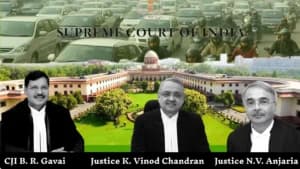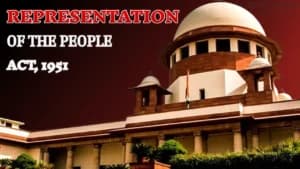In a recent judgment, the Supreme Court raised strong concerns over the increasing trend of lengthy and wordy pleadings in civil litigation, especially in tenancy disputes. The Court also flagged the alarming use of AI-generated and computer-generated statements in court submissions, stating that such practices weaken the core of a legal case and hinder the judiciary’s efficiency.
“Every word that is not a help is a hindrance because it distracts… A reader who realizes that a brief is wordy will skim it; one who finds a brief terse and concise will read every word.”
The bench of Justice Pankaj Mithal and Justice SVN Bhatti made these observations while deciding a case involving tenancy rights under the Bombay Rent Act, 1947. The case stemmed from a detailed civil suit that ultimately triggered a chain of appeals, resulting in long judgments at every level — trial, appellate, and High Court.
Read Also:- Supreme Court Hears Plea Against Allahabad High Court's Controversial Ruling in Minor Sexual Assault Case
The apex court was particularly disturbed by the eight-page plaint and sixteen-page written statement in the case of Annaya Kocha Shetty (Dead) Through LRs vs Laxmibai Narayan Satose (Deceased) Through LRs & Others. The voluminous pleadings led to an overload of oral evidence and prolonged litigation.
“The time has come for courts to invoke their jurisdiction under Order 6 Rule 16 of the Civil Procedure Code, 1908, and make litigation workable.”
Order 6 Rule 16 CPC empowers the court to strike out or amend any matter in pleadings that is unnecessary, scandalous, frivolous, or an abuse of the process of the court. The Supreme Court urged lower courts to exercise this power actively to reduce delays and improve judgment clarity.
Read Also:- Why Should Lawyers Be Spared for Misconduct?: Supreme Court Questions Bar Members Over Misleading SLP Filing
Case Background
The dispute involved the tenancy rights over Shop Nos. 5 and 6 in Shri Samarthashraya Vishranti Graha, Dadar, Mumbai. The original plaintiff claimed to be a deemed tenant under Section 15A of the Bombay Rent Act, based on an agreement with the first defendant, who was running a hotel business in the said premises.
The plaintiff argued that the 1967 agreement was a "leave and license" arrangement, making him a tenant protected under law. However, the defendants claimed it was merely an agreement to conduct the hotel business on behalf of the owner, not a tenancy.
The trial court sided with the plaintiff, treating the arrangement as a license agreement and recognizing the plaintiff as a deemed tenant.
But the appellate court and the Bombay High Court reversed this, ruling that the agreement was strictly for conducting the business and did not transfer tenancy rights. They relied on the agreement’s language and royalty receipts issued during the period. The courts noted that the payment terms, business control, and responsibilities laid on the plaintiff all pointed to a conducting arrangement rather than a landlord-tenant relationship.
Read Also:- Supreme Court: Conviction Cannot Be Based Solely on 'Last Seen' Theory Without Disproving Accused's Alibi
The Supreme Court upheld the decisions of the appellate court and High Court. It emphasized that the agreement, dated 16.08.1967, did not grant the plaintiff possession or tenancy rights but merely allowed him to operate the hotel business.
“The agreement was for conducting the hotel business, not for granting tenancy. The words used are clear, and no exception under Section 92 of the Evidence Act is attracted to allow contrary oral evidence.”
The Court examined the clauses in the agreement and noted:
- The agreement referred to the parties as "owner" and "conductor."
- It expressly mentioned the business being given on a “conducting basis.”
- The plaintiff was required to pay royalty, not rent.
- The plaintiff was responsible for all operational costs including staff wages and electricity bills.
- The plaintiff had to vacate the premises upon termination of the agreement.
- The ownership of the property remained with the original defendants.
The Court also reiterated the legal principle that mere nomenclature of an agreement doesn’t decide the nature of the arrangement — it is the terms and the intention that matter.
The Supreme Court raised an important warning about the increasing reliance on AI-generated or computer-generated statements in pleadings. It observed that while technology can aid the judicial process, AI-driven content often dilutes the legal cause and confuses the narrative.
“Courts are also confronted with AI-generated or computer-generated statements… placid pleadings will disorient the cause in a case.”
The bench remarked that AI content might enhance efficiency but could easily mislead or distract the court, especially in lengthy documents where clarity is essential.
The Supreme Court dismissed the appeal by the plaintiff and confirmed the High Court’s view that the arrangement was purely a conducting agreement. The Court also imposed a cost of ₹1,00,000 on the appellant, payable to the first defendant.
“Litigation must be made workable. The approach to pleadings needs to be re-invented — to be brief and precise.”
Case Title: ANNAYA KOCHA SHETTY (DEAD) THROUGH LRS VERSUS LAXMIBAI NARAYAN SATOSE SINCE DECEASED THROUGH LRS & OTHERS










